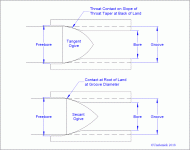The devil is in the details and several details need sorting in these. First, let's sort out the terminology. Here's an illustration I put up fourteen years ago:

Ogive contact with the comparator, seating stem, or throat happens at different locations along the ogive. That fact doesn't matter, as long as you are consistent in which one you base your measuring comparisons on. However, you may want to be aware there is typically some variation in the exact shape of bullets. This accounts for Bryan Litz's observation that BC's can vary 3% among match bullets coming out of the same box. The table below shows Sierra 150-grain 30 caliber bullets I measured had about 0.008" variation in the distance of the ogive from the base, with the variation being a little greater when the measuring point on the ogive is further above the shoulder.

The problem this creates for trying to define a single diameter as the ogive contact point is in the design of bullets. Many secant ogive bullets, if their shoulder is sharp, will first meet the rifling at its groove diameter root by contacting that location with the shoulder, as the line tangent to the start of the secant ogive is often a bigger angle than the throat angle is. A tangent ogive, on the other hand, comes off the shoulder with a tangent line coincident with the bearing surface and still a very shallow angle when it meets the throat, so it will typically meet the rifling at the bore diameter, touching the corner of the rifling and throat angle. I suspect this explains why tangent ogive bullets are able to better correct small errors in bullet tilt.
Which goes to show that you really do need to specify in your load records which comparator you are using (and perhaps to measure and record the inside diameter of the comparator throat where it touches the ogive). Otherwise some other poor b*****d is going to be seating their bullets to a greater or lesser depth if they try to duplicate your load.
It would of course be good to have a standard for this (e.g. "the SAAMI comparator shall touch the ogive at the point where the bullet diameter has reduced to 70% of maximum"), if we don't already. I am under the impression that the datum for case shoulders IS standardized.

